Air Jordan is a subsidiary of Nike, Inc. It is a brand of basketball footwear and athletic clothing produced by
Jumpman and endorsed and created for Chicago Bulls basketball player Michael Jordan. The original Air Jordan I sneaker, produced for Jordan in 1984,
were released to the public in 1985. The shoes were designed for Nike by Peter Moore, Tinker Hatfield, and Bruce Kilgore. Jordan also teamed up with nike in 2016 to create one of the first dual shoes
Since its introduction into the sports shoe market, the Air Jordan evolved from the original basketball shoes to models for different uses, including I-XXXI. The Jordan brand sponsors 21 active NBA players, including Jimmy Butler, Chris Paul, Blake Griffin, Kawhi Leonard, Russell Westbrook, and Carmelo Anthony. They also endorse Nike Air Jordan products. Also they sponsor other leagues such as the MLB, NFL, NASCAR and the WNBA.

Air Jordan I, (Royal Blue Colorway)
The
Air Jordan 1 was first produced for Michael Jordan in 1984. It was designed by Peter C. Moore.
[2] The red and black colorway of the Nike Air Ship, the prototype for the Jordan 1, was later outlawed by NBA Commissioner David Stern for having very little white on them.
[3] It is a common misconception that the Jordan 1 was banned however, it was indeed the Nike Air Ship. After the Nike Air Ship was banned, Michael Jordan and Nike introduced the Jordan 1 in color ways with more white such as the "Chicago" color way and the "Black Toe" color way. They used the Nike Air Ship's banning as a promotional tool in advertisements hinting that the shoes gave an unfair competitive advantage for the Jordan 1 and that whoever wore them had a certain edginess associated with outlaw activities.
The Air Jordan I was originally released on the market from 1985 to 1986. Then retro-ed in 1994, 2001–2004, and 2007–2016.

Nike Air Jordan II, (White/Red Colorway)
The success of the Air Jordan 1 encouraged Nike to release the New Air Jordan in 1986 for the new basketball season. Designed by Peter Moore and Bruce Kilgore, the original Air Jordan II was unique in that it was made in Italy giving the shoe a luxury feel. The Air Jordan 2 also retailed with a full length encapsulated Nike air bubble for maximum comfort. The Air Jordan 2 was the first Jordan not to have the Nike swoosh on the upper. The Air Jordan II was originally retailed at $100. The Air Jordan was originally released from 1986 to 1987. The model was revived from obscurity when Air Jordan collaborated with Just Don to create the Just Don x Air Jordan 2. The shoe featured premium blue quilted leather inspired by a Chanel handbag and released in very limited numbers on January 31, 2015 for $275. The shoe was released again in a Beach colourway bundled with a premium snapback and gold pin for $650 on January 30, 2016. Then retro-ed in 1994, 2004–2005, 2008, 2010, 2014–2016.

Nike Air Jordan III, (White Cement Colorway)
The Air Jordan III was designed by Tinker Hatfield who works for Nike as a designer for stores and offices. By that time Michael Jordan was ready to leave Nike, but the Jordan III changed his mind. It was the first Air Jordan to feature a visible air unit on the heel, the new Jumpman logo, an elephant print trim and tumble leather to give it a luxury look. The Air Jordan III was also famous for the humorous ads depicting Spike Lee as Mars Blackmon, the character he played in his film 'She's Gotta Have It'. This campaign was known as the "Mars and Mike" ad campaign, which was one of Nike's most successful advertisement campaigns. These were the first Jordan's to feature the "NIKE AIR" logo on the back, but later replaced by the Jumpman logo, with the words "AIR" underneath it, similar to the Air Jordan VI. These were said to be Michael Jordan's favorite shoes, he wore them during the 1988 Dunk Championship and many other events in his basketball career. The Air Jordan III's had poor sales when first reintroduced in 1994. On their second reintroduction in 2001, they sold well. The "Fire Red" Air Jordan III was released in March 2007, and late again in 2013.
In 2007, Jordan Brand collaborated with director Spike Lee to release a limited pair of Air Jordan III's the Do The Right Thing movie poster. The same year also saw the reintroduced versions of the Air Jordan III's in two monotone colorways, all black and all white, nicknamed the "Black Cats" and the "Pure Moneys" respectively. 2007 also had the "Flips" which moved the elephant print from the trim to the entire shoe and replacing it with white leather, indeed "Flipping" the original design of white leather with elephant print trim.
In 2009, the Jordan Brand reintroduced the highly sought after
Air Jordan III in the True Blue colorway. It was an international-only release, meaning they were not sold in the US. In 2011, the brand released a Black History Month (BHM) Air Jordan III colorway in commemoration of the 35th anniversary of Black History Month. The sneaker is black with gold trim and stitching as well as laser print around the toe and heel. The
BHM III was a very limited release and there was said to have been no more than 3,000 pairs made. Also, the same year saw the release of the "True Blue" III on June 4. The Stealth colorway of the III was released in September and the Black Cements were released in November.
[4] The "Black Flips" were released on December 3, 2011. In 2013, Jordan released a special edition of the Jordan III this shoe was deemed the Air Jordan III "Retro '88" White Cement and were released in February.
The Air Jordan III was originally released in 1988. The multiple retros and new colorways have been released in 1994, 2001, 2007, 2009, 2011, 2013, 2014 and 2016

Nike Air Jordan IV, (White Cement Colorway)
In 1989 The Jordan IV shoe was released into the public, designed by
Tinker Hatfield. It was the first Jordan shoe released on the global market. It had 4 colorways: White/ Black-Cement Grey, Black/Cement Grey, White/Fire Red-Black, and Off White/Military Blue.
Spike Lee, the director and actor helped in the ads for Jordan IV. Spike Lee had featured the Air Jordan IV in his movie
Do The Right Thing. The Air Jordan Bordeaux "Spiz'ike IV" were specifically made for Spike Lee in order to pay respect for advertising the Jordan Cement 4's.
The Air Jordan IV were on Jordan's feet when he made "
The Shot" in Game 5 of the 1989 NBA First Round between the
Chicago Bulls and the
Cleveland Cavaliers. In 2012 a Cavalier Colorway dubbed The "Cavs IV's were released to honor "The Shot"
The Air Jordan IV was originally released in 1989. It was re-released in 1999 and retro-ed in 2000, 2004, 2006, 2008, 2010–2013 and 2015–2016. Latest retroed colorways are: Air Jordan 4 "Legend Blue", Air Jordan 4 "Oreo" in early 2015, and the Air Jordan 4 OG "Cement" released on February 13, 2016.
[5]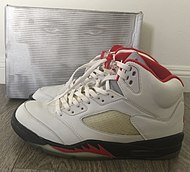
Nike Air Jordan V, (Fire Red Colorway)
The Air Jordan V was released in February 1990, designed by
Tinker Hatfield again. Some elements were carried over from the Air Jordan IV, but overall they were a completely new look. Some of its new features were a reflective tongue, translucent rubber soles and lace locks. The soles gave them a new look, but it yellowed over time when exposed to moisture and were the source of many complaints early on due to the slippery nature of the soles when collecting dust.
Hatfield is believed to have drawn inspiration for the Air Jordan V from World War II fighter planes, which was most notably visible in the shark teeth shapes on the midsole. The Air Jordan V was reintroduced in 2000, including a new color way featuring Michael Jordan's high school (Laney High) colors. In 2006 several V's were reintroduced, including the LS "Grape" V's, the LS "burgundy" V's, the "Fire-Red" V's, the "Green Bean" V's, and "Stealth Blue V's. Along with the latter, a very limited laser design and the black/metallic/fire red colorways were released in early 2007.
In the month of May 2009, Air Jordan confirmed the release of an "DMP II" consisting of two Air Jordan V's.
[6] The second color way features a 3M material base with black laces and midsole. The retail price was $310.
The Air Jordan V was originally released in 1990. It was retroed in 2000, 2006–2009, 2011 and 2013–2016.
The Air Jordan V saw a lot of use in popular sitcom
The Fresh Prince of Bel-Air. During many episodes you can see Will Smith wearing the 'metallic silver', 'grape', and 'fire red' colorway. To pay tribute to his character, Jordan released the Air Jordan 5 Bel Air in 2013.
[7]
Air Jordan VI- 2010 Retro (Black/Varsity Red Colorway)
The Air Jordan VI had a new design by Tinker Hatfield and released in 1991. The Original 5 colorways were: Black/Infrared, White/Infrared, White/ Carmine-Black, White/Sport Blue, and Off White/Maroon. The Air Jordan VI introduced a reinforcement around the toe, It had two holes in the tongue, and a molded heel tab on the back of the sneaker (demanded by Jordan so it wouldn't hit his
Achilles tendon). Like the Air Jordan V this sneaker also had Clear rubber/"Icy" Soles. The Air Jordan VI was the last Air Jordan to feature the Nike Air logo on it.
Later that year the
Bulls defeated the
Lakers in the
1991 NBA Finals, with Jordan (wearing the Black/Infrared) named as the
most valuable player. That was also the first NBA Championship won by Jordan and the Bulls. The Jordan VI was also seen in the film
White Men Can't Jump, which was produced in 1991 and released one year later.
The Air Jordan VI has been retro-ed many times since its original release in 1991, Notable releases were in 2000, 2002, 2005, 2008, 2010, 2012 and 2014 with the Black Infrared Colorway.
In addition to a Porsche-inspired rear pull tab and visible air the Air Jordan VI was the first Jordan with an inner bootie.
The Air Jordan VI was originally released in 1991. It was retro-ed in 2000, 2002, 2006, 2008–2010, 2012 and 2014–2016.
The Air Jordan VI saw much of screen time in 2015's
Creed. Adonis Johnson (
Michael B. Jordan) can be seen sporting the black/infrared and the white/varsity red-black colorway through most of the movie,
[8]most notably during the training montage before the big fight that Rocky films are known for.
[9]The VI was the first shoe used by the protagonist of
Slam Dunk, Hanamichi Sakuragi.
[10] Nike released special versions of both the VI and the Jordan Super.Fly 3 featuring artwork from the series in 2014. The VI also had Sakuragi's number 10 embroidered on the side of the heels.
[11] Various other models in the Air Jordan line are featured in the series, including the original (which Sakuragi eventually switched to), the V, and the XII (both worn by Sakuragi's rival, Kaede Rukawa).
[12]The Air Jordan VII was released in 1992 with a new design by Tinker Hatfield. This shoe introduced the huarache technology which allowed the shoes to better conform to the user's foot. A few things were no longer featured on the new model, such as the visible air sole, the Nike Air logo, and the yellowing soles. This was the first Air-Jordan in the line that did not have any distinctive "Nike Air" on the outer portions of the shoe. The "Nike Air" branding was still on the in-soles, which Air Jordans VIII-XI also had. The VIIs were also known for a successful ad campaign in which
Bugs Bunny appeared alongside Michael Jordan to market the shoes.
When Jordan went to compete at the 1992 Barcelona Olympics to play for the US Men's Basketball Team (also known as the "
Dream Team"), Nike released a special Olympic color combo of the Air Jordan VII model which had Jordan's Olympic jersey number, 9 even though most of the jordans that were made, especially the Air Jordan VII had a "23" on the back.
Various models of the Air Jordan VII were re-released in 2002, again in 2004, and again with different colors in 2006. Also in 2008 Nike released a black and blue pair owned only by Cheikh Mbacké, ordered for $600.
In 2011 the Air Jordan VII saw releases in the "Orion" and "Bordeaux" colorways. Other colorways are confirmed for a 2011 release as well, such as the "Cardinals" which is a re-release and "Year of the Rabbits". The "Olympic" and "Charcoal" (commonly referred to as Raptors) were re-released in 2012.
The Air Jordan VII was originally released in 1992. It was retro-ed in 2002, 2004, 2006, 2008–2012 and 2015–2016.

Nike Air Jordan VIII, (Playoffs Colorway)
The Air Jordan VIII was released to coincide with the 1992–1993 NBA season. The eighth model of the Air Jordan was noticeably heavier than its predecessors. This shoe had a lot more detail than most of the earlier Air Jordan's such as two crossover straps on each shoe and a Jumpman. Thus the Air Jordan VIII model became known as the "Punisher" because of the advanced basketball ankle support and enhanced traction. This shoe contains a full length air sole,
polyurethane midsole,
polycarbonate shank plate, and two crossover straps (for added support and more custom fit).
The Air Jordan VIII was originally released in 1993. It was retro-ed in 2003, 2007, 2008, 2013 and 2015–2016.

Nike Air Jordan IX, (Bulls Colorway)
Originally released in November 1993, the Air Jordan IX model was the first model released after Michael Jordan's retirement. Jordan never played a full season of NBA Basketball wearing these shoes. This model was inspired by baseball cleats that Jordan wore when playing minor-league baseball.
Like the
VII and
VIII models, the
Air Jordan IX featured an inner sock sleeve and
nubuck accents. The sole featured different symbols and languages of different countries. The
Air Jordan IX has been the shoe chosen to adorn Jordan's feet for his statue outside of the
United Center in
Chicago.
In popular culture, in the children's movie
The Little Rascals one of the bullies, Butch is wearing a pair of these shoes. American rap icon
Tupac Shakur also wore
Air Jordans in a popular "Thug Life" photo set in 1993.
The Air Jordan IX was originally released from 1993 to 1994. It was retro-ed in 2002, 2008, 2010, 2012, 2014–2016.

"NIke Air Jordan X
, (Steel Colorway)This was released in 1995 in 8 different colors, Black/grey, varsity-black, off-white/black/varsity red*, Powder Blue (worn by UNC's Men's and Women's basketball teams), Orlando Magic*, New York Knicks*, Seattle SuperSonics*, and Sacramento Kings*. It was the first Air Jordan to feature a lightweight phylon midsole. The shoe also featured all of Michael Jordan's accomplishments on the outsole of the shoe.
In 2012, the Air Jordan X was re-released. They are dubbed the "Chicago Bulls", as they are part of a regional pack (City Pack), representing five teams. The lacing and tongue are completely black, and the red inner lining contrasts with the red inserts on the outsole. The outsole's design features a striped (wavy) design, which list many of Jordan's accomplishments. They retailed at $160. The Air Jordan X was released again in an OVO collaboration in 2015 and 2016, releasing in white and black colorways respectively with stingray detailing.
The Air Jordan X was originally released from 1994 to 1995. It was retro-ed in 2005, 2008 and 2012–2016.

Nike Air Jordan XI, (Bred Colorway)
This model was designed by
Tinker Hatfield. When the shoe launched, Michael Jordan (retired from basketball by then) was trying in minor baseball leagues. Hatfield designed the sneaker waiting for Jordan to come back and hoping he would play in them.
The ballistic mesh upper of the sneaker was meant to make the Air Jordan XI lighter and more durable than the past sneakers. Further changes came with the use of a carbon fiber spring plate in the clear out sole, giving the shoe better torque when turning on the court. The highlight and arguably most well-known aspect of the shoe is the patent leather mudguard. Patent leather was lightweight, when compared to genuine leather, and also tended not to stretch as much – a property to help keep the foot within the bounds of the shoe bed during direction changes on the court. The patent leather gave the XI a "formal" look. When this shoe released, some wore this model with business suits instead of dress shoes.
The sneakers were only samples in 1995 when Jordan decided to come back in the NBA. Hatfield and Nike discouraged Michael Jordan playing in them, but when produced he wore them. Also noteworthy, Jordan violated league dress code by wearing the shoes, as his teammates wore all black shoe. He was fined $5,000 for not following the Bulls colorway policy. After the fining, Nike made him a pair of the shoes in a black/white/concord colorway for the series against Orlando. A similar black/white/royal blue colorway was released to the public at the end of 2000. The colorway was changed for the public release because the concord purple had looked like royal blue on TV.
Jordan wore the
Air Jordan XI model to help the Chicago Bulls claim the
1995–96 NBA Championship, he also wore the Air Jordan XI white Columbia colorway in the
1996 NBA All-Star Game and was selected
MVP of the game. The shoes received more media exposure when Michael Jordan wore the
Air Jordan XI model in the 1996 animated movie
Space Jam. These shoes were eventually released in 2000 and re-released in 2009 with the nickname
Space Jams. The concord purple was changed to royal blue for the released versions of the shoe.
The Air Jordan XI was originally released from 1995 to 1996. It was retro-ed in 2000, 2001, 2003, and 2006–2016. The Air Jordan XI is the most popular Air Jordan's in the series, and has released almost ritualistically every December since 2008 and sells out within minutes, also it is Tinker Hatfield's favorite.

Nike Air Jordan XII, (Playoffs Colorway)
The
Air Jordan XII was inspired by
Nisshoki (the Japanese flag), and a 19th-century women dress boot. However, featuring gold-plated steel lace loops, embossed lizard skin pattern and a full length zoom air unit with a carbon fiber shank plate, this model set a new direction in style and technology in shoe design. Though not as light weight as previous models, the construction and firmness of the shoe is widely considered to be the most durable and sturdy shoes from the
Air Jordan line. The first model released after the creation of subsidiary Jordan Brand, the Air Jordan XII has no
Nike branding on it of any kind, while all the models before it have
Nike Air or other
Nike branding outwardly (Air Jordans I-VI) or just simply on the insoles (Air Jordans VII-XI). This shoe came in 5 colorways and was released on March 13. The shoe was re-released on December 25, 2008 with the Eleven as the final countdown pack. In addition, the Twelve was combined with the Thirteen numbered Jordan to produce the 12.5. As of today, the 11/12 countdown package (retro) retails for
US$750–US$800, well above the starting price of US$310. The Air Jordan 12 has been subject to many highly limited colorways recently such as the
Air Jordan 12 x PSNY collaboration, the
Wings colorway that was limited to 12,000 pairs, and the
OVO collaboration.
The Air Jordan XII was originally released from 1996 to 1997. It was retro-ed in 2003, 2004, 2008, 2009, 2011–2013, and 2015–2016.
[13]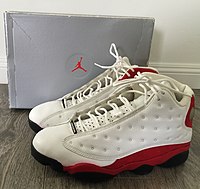
Nike Air Jordan XIII, (White/black-varsity red Colorway)
In 1997, Air Jordan XIII's were released to the public. This model was known for its cushioning along the feet, designed by Hatfield. The Black Panther was the inspiration for the Air Jordan XIII, the sole resembles the pads on a panther's paw. But also the panther is the hologram on the back of the shoe which imitates a panther's eyes in the dark when light is shined at them. They were re-released in 2005, which coincided with the release of the Air Jordan 8s shoe.
In the movie
He Got Game, the Air Jordan XIII was worn by Jake Shuttlesworth (Denzel Washington).
Ray Allen, who played Jake's son Jesus in the film, wore them when he broke
Reggie Miller's all-time record for made three-point shots during a game against the Lakers in Boston during the 2011 season. The Jordan Brand re-released the
Air Jordan XIII at the end of 2010, which included the French Blue/Flint Grey, White/Red-Black, 'Playoff' color way and the Black/Altitude Green color way.
The Air Jordan XIII was originally released from 1997 to 1998. It was retro-ed in 2004, 2005, 2008, and 2010–2015.

Nike Air Jordan XIV, (Black Toe Colorway)
Inspired by the
Ferrari 550 M which Michael Jordan owned, the Air Jordan XIV was originally released from 1998 to 1999. It was re-released in 2005, 2006, 2008, 2011, 2012 and 2014–2016.
The Air Jordan XIV co-styled by the famous Tinker Hatfield and Mark Smith was made race ready and equipped with the Jordan Jumpman insignia on a Ferrari shaped badge. In addition, these shoes include breathable air ducts on the outer sole. The color scheme of predominant black accentuated with red was nicknamed "The Last Shot" because Michael Jordan wore them as he hit the game winning shot over Bryon Russell, of the Utah Jazz, in his final game with the Chicago Bulls in the 1998 NBA Finals.
There are 14 Jumpman logos on Air Jordan XIV's—7 on each shoe—corresponding the shoes' number in the series. They can be found in the following places:
- Near the toebox x 1
- Shield Logo near the achilles heel x 1
- Above the number "23" at the heel x 1
- At the bottom sole (middle part) x 1
- Steel Lacetips x 2
- Insoles x 1
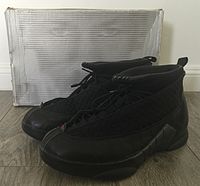
Nike Air Jordan XV, (Stealth Colorway)
This was the first shoe after Jordan's retirement. The design of the XV's originated from the aircraft prototype X-15, which was developed by NASA during the 1950s. The sides of the XV were made from woven kevlar fibre. The
Jordan XV's were the first
Air Jordan's to be negatively received in a while (the last being the
Air Jordan 2's), because the quality on the Jordan shoes was bad.
[14]The Air Jordan XV was originally released from 1999 to 2000. It was retro-ed in 2007 and 2008.

Nike Air Jordan XVI, (Bulls Colorway)
Air Jordan XVIs, designed by Nike's Senior Footwear Designer Wilson Smith, were released in 2001. This meaning it was the first design since the II's that Tinker Hatfield was not behind. Smith decided to bring in a few design elements/fabrics from earlier releases. The shoe featured the return of the clear rubber sole (V, VI, XI) and patent leather (XI).
Unique to the Air Jordan XVI was a gaiter/shroud that covered the shoe and could be removed to give the shoe a new look. Not only was this for fashion purposes, it also had a thermal functionality.
The shoe was said to be stiff and that the shroud/gaiter could easily fall off when playing basketball. The black/red and white/midnight navy versions of the shoe both featured patent leather which very easily creased and cracked.
[15]The Air Jordan XVI was originally released in 2001. It was retro-ed in 2008, 2014 and 2016.

Nike Air Jordan XVII, (Wizards Colorway)
This pair of Jordan's come equipped with Keefer, which held the shoes and a
compact disc containing the
Air Jordan XVII song. The retail price of the shoe was US$200. The defining functional design element of the
Air Jordan XVII model, which was later replicated on the
Air Jordan XXIII model, was the reinforced mid-sole which provided a sturdy and stable chassis for the shoe. They were made in four mid top colors and three low-top colors.
The Air Jordan XVII was originally released in 2002. It was retro-ed in 2008 and 2016.
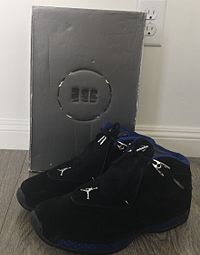
Nike Air Jordan XVIII, (Wizards Away Colorway)
The
Air Jordan XVIII shoe was released in 2003, and was the shoe for Jordan's last season, in which he played for the
Washington Wizards.
The shoe was designed by Air Jordan Senior Footwear Designer, Tate Kuerbis, a person that had been part of the Jordan footwear design team since 1999 and with Nike since 1995. The inspiration for the design came from a number of things; sleek racing lines of the auto world, carbon fibre-based monocoque of F1 race cars, race car driving shoes (rubber heel wrap) and Fine Italian dress shoes (bold stitching on the soles).
The Air Jordan XVIII was originally released from 2003 to 2004. It was retro-ed in 2008.

Nike Air Jordan XIX, (Black Mamba Colorway)
Released in 2004, this is the first Jordan release after his third, and final, retirement which came after the
2002–03 NBA season. The design was inspired by the
Black Mamba snake, and two original colorways where released: white/flint grey and black/red. Three regional colorways and three special edition colorways were released. They consisted of the East, West, and Midwest edition for regular and West, East, and Olympic for the SE (special edition).
The
Air Jordan XIX used innovative materials. The upper section of shoe was developed in collaboration with the global materials consultancy
Material ConneXion, who sourced Nike a sleeving normally used in architectural applications for protecting
PVC pipes from bursting. In theory, this allowed for a shoe without laces, because the sleeving does not stretch. Nonetheless, the
Air Jordan XIX model did include a set of laces behind the sleeve to better secure the shoe. They are the lightest Air Jordans ever made.
[citation needed]The Air Jordan XIX was originally released in 2004. It was retro-ed in 2008.

Nike Air Jordan XX, (Bulls Colorway)
The Air Jordan XX was also inspired by bicycling shoes. The strap was placed in the center of the shoe over the laces. It also helped to create a tighter fit and increased support.
The Air Jordan XX was originally released in 2005. It was retro-ed in 2008 and 2015.
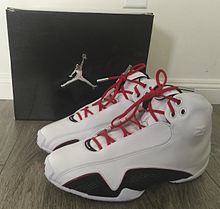
Nike Air Jordan XX1, (Bulls Colorway)
The
Air Jordan XXI model of shoes was designed by
D'Wayne Edwards and inspired by sport touring vehicles. The shoe features lower-foot air grilles, double-overlasted Phylon midsole, a carbon fibre shank plate and a seamless diamond-quilted booty. It also has a tenable I.P.S. suspension system that lets the wearer choose between Zoom and Encapsulated air.
The
Air Jordan XXI was introduced on television by the "
Second Generation" advertisement.
The Air Jordan XXI was originally released in 2006. It was retro-ed in 2008.

Nike Air Jordan XX2, (Bulls Colorway)
The
Air Jordan XX2/
XXII shoe model, designed by D'Wayne Edwards, was released on March 24, 2007. The original retail price of the model was US$175. The aggressive and sharp design was inspired by the
F-22 Raptor fighter jet. Some technical features of the shoe include an updated visible and interchangeable I.P.S. suspension system, a new metallic mesh for ventilation, the Air Jordan camouflage pattern printed in reflective 3M material, and an updated traction system, based on an army general's stripes.
Two special editions of the Air Jordan XX2 model were released. The first edition was released for Jordan's birthday on February 17. This edition featured authentic Jordan Brand basketball leather. The second edition was the Omega model, part of the Alpha-Omega package. This model featured a laser-etched image of Jordan after he won his sixth NBA championship in 1998.
The Air Jordan XX2 was originally released in 2007. It was retro-ed in 2008.
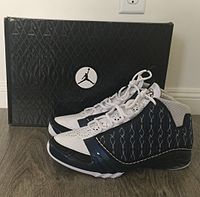
Nike Air Jordan XX3, (Wizards Colorway)
The Air Jordan XX3 was designed by Tinker Hatfield. It was a unique model, being the first basketball shoe to be included in the "Nike Considered" category, for using materials from not more than 200 miles from a Nike Factory. It features a hand-stitched exterior, full-length bootie, carbon fiber shank plate, the last to feature interchangeable IPS pillars, and an articulated chassis. The shoe was released on January 25, 2008, and was the last Air Jordan until the XX8 to have
Roman numeral identification.
The Air Jordan XX3 was originally released in 2008. It was retro-ed in 2015–2016.
The Air Jordan 2009 was designed by Jason Mayden and was the first Air Jordan model named after the year of its release rather than its numbered system. Inspired by Jordan's defensive focus, the shoe incorporates Articulated Propulsion Technology used by
Paralympian runners. It also features a durable pleated silk upper, protective TPU chassis, carbon fiber arch plate and Zoom Air structure. The shoe was released on January 31, 2009.
The Air Jordan 2009 was originally released in 2009. It has not been retro-ed.

Air Jordan 2010, "
Welcome Home" Colourway
This is the 25th anniversary of the Air Jordan brand, and although commonly called the Jordan 2010s, is also referred to as Air Jordan XX5/XXV. This model of shoe was announced on November 12, 2009, for a release date of February 13, 2010, retailing for US$170. Dwyane Wade is endorsing the AJ 2010.
The base of the each mid-sole has stylized text that when combined reads: "I've failed over and over and over again in my life. And that is why I succeed." This quote was originally attributed to Michael Jordan, and is a reference to an advertising campaign that aired in 1997 with Jordan detailing his failures that led to his success in his career.
The Air Jordan 2010 was originally released in 2010. It has not been retro-ed.

Air Jordan 2011, year of the rabbit colorway.
The
Air Jordan 2011 was endorsed by Dwyane Wade in 2011, Jordan Brand decided to keep the fans happy with the release of the
Air Jordan 2011. The shoe has inter-changeable insoles- The Red, "Explosive" one is claimed to symbolize power, and a Blue, "Quick" one, supposedly for quickness. Four colorways of the shoe were released on February 19, 2011 in correspondence with the 2011 All Star Game. The first colorway was White/Black. There were also White/Red and White/Blue colorways that coincided with the East/West Jersey Colors. The "Year of the
Rabbit" colorway was a limited release that celebrated of Michael Jordan's
Chinese zodiac sign, coinciding with the current zodiac sign, the Year of the
Rabbit.
The 2011 has a unique design along both sides of the shoe. It is a star-constellation pattern that also serves as breathing holes for the shoe to keep it well ventilated. It uses Patina Leather wrapped around the shoe. The shoes are hand burnished and crafted. A dress shoe feel similar to the XI was reported to be the goal. o The Air Jordan 2011 was originally released in 2011. It has not been retro-ed.
Air Jordan 2012 offers six customization configurations. Two interchangeable sleeves and three insoles adapt to different playing styles. The Deluxe model was launched on February 8, while the customization Flight models were released on February 25, 2012. It was the final Air Jordan model to be named after the year it was released as the numbered system returned in 2013 with the Air Jordan XX8.
The Air Jordan 2012 was originally released in 2012. It has not been retro-ed.
The Air Jordan XX8, designed by Tinker Hatfield, was released on February 16, 2013. This premiere model featuring a mostly black upper and volt Dynamic Fit bootie. A heel and forefoot Nike Zoom unit in combination with the new Jordan Flight Plate, Dynamic Fit straps for increased support, a carbon fiber heel counter for additional support, and its most notable feature, the mesh upper for flexibility and ventilation. Jordan Brand has decided for 2013 to returning to the Air Jordan numbered order after having stopped at XX3. The Air Jordan 2012 featured different technology which including interchangeable insoles for various styles of play, a concept introduced with the Kobe System. The exterior shroud gives the shoe a sleeker look than any other and is 8 inches high on the ankle but unzips and folds down revealing the bright volt green interior.
The Air Jordan XX9, also designed by Hatfield, released in September 2014 in both an elephant print and a knit edition. The shoe has already been debuted in the NBA by
Russell Westbrook and
Kawhi Leonard. The shoe has Flight Web for superior lockdown, a performance woven upper for comfort, support, strength, and protection, and a re-engineered Flight Plate. The XX9 also released in a pack alongside the iconic Air Jordan XI on December 23, 2014 called the "Ultimate Gift of Flight" pack.
[17]The Air Jordan XXX (30) debuted on January 14, 2016 at an exclusive media event in Chicago. It was again designed by Tinker Hatfield. The first colorway of the shoe released on February 16.
[18] The shoe consists of an upper and outsole very similar to that of the XX9 of the previous year. The upper is a combination of performance woven and flyknit that is new for the brand in 2016, and also has a flyknit-constructed ankle collar that extends slightly past where the collar of the shoe would normally be. Jordan brand has also brought back functional Dynamic Fit in the lacing system. The outsole/midsole is almost identical to the XX9, with very minor technical tweaks. The outsole boasts a more noticeable change, with a different traction pattern unique to this shoe, while the midsole remains almost entirely the same. The only difference in the midlsole cushioning setup from the Jordan XX9 is a material change in the Flightplate setup, which is now named Flightspeed and is constructed of a plastic rather than carbon fiber for more flexibility while remaining structural integrity.
The Air Jordan XXXI (31) was unveiled on July 20, 2016. The sneaker is heavily influenced by the Air Jordan 1's having a leather upper and both a Nike
swoosh and a Jumpman logo plus a Jordan "Wings" logo.
[19] Its first retail debut was on September 3, 2016 in the "banned" colorway for $185 alongside its air Jordan 1 counterpart.
[19] Notable appearances of the AJ 31 include the "USA" colorway worn during the 2016 Olympic basketball tournament by members of team USA.
[20]Basketball at the 2016 Summer Olympics – Men's team rosters












 In the examples, you’ll see Facebook employees dropping hats onto their heads, blowing their faces with air, or cracking a slow but subtle smile. The profile videos feel a bit like the Harry Potter newspapers, where photos suddenly come alive. They’re sure to unlock a ton of creativity from the user base.
In the examples, you’ll see Facebook employees dropping hats onto their heads, blowing their faces with air, or cracking a slow but subtle smile. The profile videos feel a bit like the Harry Potter newspapers, where photos suddenly come alive. They’re sure to unlock a ton of creativity from the user base.

 At first glance, the changes might seem merely aesthetically pleasing. And truthfully, that was the only task of the team that designed them. But the repercussions for Facebook’s business could be significant, just like a similar overhaul of web profiles in 2010 was.
At first glance, the changes might seem merely aesthetically pleasing. And truthfully, that was the only task of the team that designed them. But the repercussions for Facebook’s business could be significant, just like a similar overhaul of web profiles in 2010 was.







































